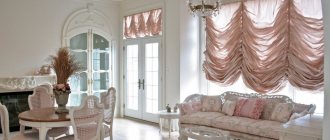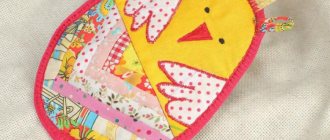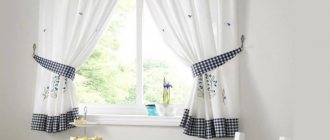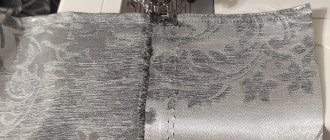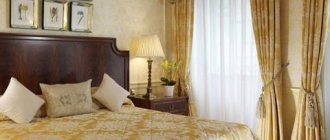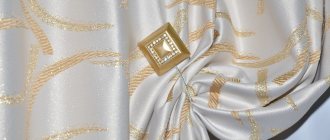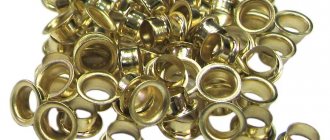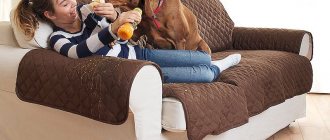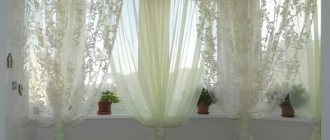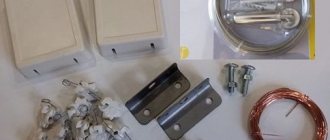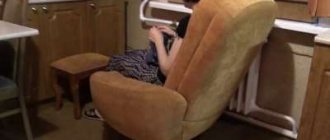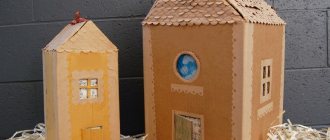Hinged curtains are an excellent solution to change the design of any room beyond recognition.
Designs such as curtains with loops can be found in a store, ordered from a studio, or sewn with your own hands. They can be decorated with bows, coins and other paraphernalia suitable for a specific room. When there are no ready-made options, all that remains is to find out how to make loops on curtains with your own hands, which is not only more economical, but also more enjoyable, because you can be proud of the fruits of your work.
Features of curtains with loops
Like any model, curtains with hinges have their strengths and weaknesses. However, the advantages still outweigh.
A wide variety of decorative techniques are used in the design of window spaces.
- Elegant appearance. When the fabric and loops are made of the same fabric, the impression of integrity is created. And if contrasting materials are chosen, it looks creative.
- Curtains are not damaged by metal or plastic fasteners;
- There is no noise when the curtains are opened or closed, the canvas moves easily;
- Even curtains that look unattractive at first glance can be “colored” with bright loops. The material for the hinges may vary;
- A harmonious combination of contrasting loops with ruffles and flounces of the same color looks impressive;
- Such curtains appropriately complement any interior design.
- The hinged fastening will hold both massive curtains and light tulle.
The current trend in window fashion is curtains with hinges.
If we talk about shortcomings, then there is, perhaps, only one - wear of the hinges. But, firstly, this will not happen so quickly, and secondly, the hinges can be easily replaced. If desired, this problem can also be solved by inserting an additional layer of synthetic fabric into the loops. In this case, wear resistance increases, and the hinges will slide more easily along the cornice.
This is a new and effective way to attach curtain fabric to a rod.
Loops are divided into two types:
- deaf;
- removable.
The limitless variety of options for this type of fastener makes it possible to choose curtains to suit any interior.
Blind loops are sewn into the fabric, and removable loops are attached using various devices. These can be buttons, Velcro, ties. The range of possible options is huge; if your imagination allows, come up with your own exclusive option. You will not break any rules; in this case, experiments are welcome.
Such curtains are appropriate both in the classic version, and they can be used to decorate English, French and Austrian models.
Additional decorations
Even the simplest curtain models will sparkle in a completely new way if you complement them with various decorative elements.
Lambrequins
Lambrequins will give a sophisticated and chic look to even the simplest options.
You will need:
- fabric (usually the same as when sewing curtains);
- threads in color;
- bias tape.
Step by step guide:
The advantages of lambrequins are that they are not difficult to manufacture and, at the same time, significantly decorate the room.
Roses for curtains
There are two ways to make roses for decorating curtains:
As a result, you will get a very realistic and beautiful flower.
Options for different rooms
The most common model is straight fabrics with loops made of the same fabric. However, time makes its own adjustments, and the Roman version is becoming more and more suitable for many. Roman blinds confidently entered our daily lives relatively recently, and, it seems, have settled in for a long time. A variety of designs, a wide color palette and maximum functionality have made them a must-have in interiors of different styles. And the hinged model is in demand more than ever.
This Roman blind is suitable for a kitchen window, a modern-style living room, as well as a bedroom or nursery.
If you want to complement this model of curtains with lambrequins or flounces, this is permissible, but it is better if additional elements are also attached on hinges.
This type of mount is ideal for Roman blinds.
For kitchen
An interesting detail: curtains with hinges have their origins in the kitchen. After all, they are a derivative of the beloved Provence or rustic style. Therefore, it is not surprising that today such curtains are most often used to decorate a window opening in the kitchen. They look very cozy and homely, do not take up much space and are very functional: they make it easy to open and close the window. And for a kitchen space, this is exactly what you need – to make it pleasant and conducive to the work process.
The most interesting are the models made independently at home.
Models suitable for the kitchen vary in color and design. For example, some people prefer delicate shades and small, unobtrusive patterns, while others, on the contrary, prefer bright accents and bright prints. Curtains with hinges will perfectly withstand both options. In addition, there are fans of curtains up to the window sill, while others prefer long curtains, and again, the model allows you to bring both solutions to life.
Hinged curtains have become popular not only due to their beauty and style. They are extremely easy to use.
For the living room
Curtains for the living room are chosen with special care, since this is the place where guests are usually invited. Curtains with hinges are an ideal option for the hall. They look strict, and, at the same time, elegant and stylish. Functionality and conciseness. This design will appropriately complement several windows nearby, and one small window.
By choosing the right cornice and curtain model, you can visually increase the size of the room and make it more comfortable.
To give familiar canvases an interesting look, you can place the loops at a slightly greater distance than is assumed in the classic version of “loop curtains.” Thanks to this trick, the lower edge of the canvas will hang in flounces, and unusual “scallops” will form in the upper part. Such a curtain will effectively complement a thick curtain fabric.
The fabric fastening option is very durable and can support a massive curtain.
For the bedroom
To create the perfect atmosphere of peace and quiet, curtains with hinges are an excellent option. First of all, because with their help you can easily adjust the level of illumination in the room. And if desired, generally minimize the amount of sunlight. Special curtain fabrics will help with this.
This model of curtains in the bedroom will look very gentle and romantic.
Important! The curtains in the rest room should not sag. Therefore, a rigid tape is sewn to the top of the curtain to completely fix the structure. Thanks to this, a beautiful, uniform drapery is formed.
Such curtains are appropriate in almost any room.
Getting ready for cutting
So, the preparation is almost complete, all that remains is to cut the fabric, you can also choose the decor. To finish sewing we need the following tool:
- Ruler;
- Scissors;
- Electric sewing machine;
- Threads;
- Iron and ironing board.
We start by setting up the ironing board and setting the temperature on the iron according to the type of fabric. You also need to check how the machine sews on a piece of fabric and, if necessary, adjust the stroke of the machine. After all, you can sew beautiful curtains, but a crooked machine stitch will ruin the result. The thread tension and needle thickness are adjusted, the latter being selected based on the thickness of the fabric. Now all that remains is to make simple curtains with your own hands.
How to sew curtains with hinges with your own hands
Externally, such models look incredibly stylish, and not everyone will realize that they can be easily sewn with their own hands. Having basic sewing skills, and even being comfortable with your grandmother’s sewing machine, you can create creative “clothes” for the window in a couple of evenings.
Curtain loops are distinguished by a variety of shapes, sizes, and materials from which they are made.
In order for the curtains to decorate the interior and fit, you should carefully take measurements. We determine the width of the future curtains. To do this, the length of the cornice must be multiplied by a certain coefficient. Its value depends on how “deep” the drapery you want to get as a result. Typically the coefficient is selected in the range from 1.2 to 2.
Everyone can choose an option to taste and even do it themselves.
The length of the curtains will depend, among other things, on the depth of the drapery. Because for a curtain with pleats the loop length is 15 cm, and for a smoother curtain it is 10 cm.
Another important nuance: the distance between the loops should exceed their width. Compliance with this unspoken rule allows you to give a more interesting and finished look to the entire structure.
At the top of the curtains, stripes of the main material or any colored strips of fabric are sewn as decoration.
So, having finished with the measurements, you can start sewing. First, we transfer the calculations from paper to canvas. Mark where the loops will be and sew the edges. Then we move on to sewing curtain loops. If you are not looking for easy ways and it is extremely important for you that both the curtains and the loops are made of the same fabric, then be patient and get to work! First, we cut out the required number of rectangular fragments from the fabric, from which we will make loops. Fold the right side inward and stitch, leaving about 5 - 7 mm along the edge, and one side to turn inside out. Then we turn out the finished loops, carefully straighten them and iron them.
Using such a curtain is as convenient as using a product with buttons.
There are two ways to attach loops to the fabric: like a pocket, hiding both edges of the loop inside the curtain, or along the top, hiding the edges under a decorative ribbon.
Hinges as fastenings can only be used on smooth cornices, because the canvas must slide freely.
The cornice itself can be metal, wood or plastic.
Important! If you prefer blind hinges, remember that you can remove the fabric for washing only by completely disassembling the cornice. And if we are talking about curtains in the kitchen or in the nursery, which have to be washed more often than all the others, this model is unlikely to be suitable. This means that it is better to choose removable hinges.
Colored loops made of contrasting material look beautiful and unusual.
If you sew curtains yourself, the most affordable option is buttons or Velcro. Having sewn one end of the loop to the canvas, we sew Velcro onto the same place. The second part of the Velcro is sewn to the other edge of the loop. Using the same principle, you can make loops on buttons or other decorative parts.
Deciding on color and size
After the style is chosen, you need to choose the appropriate color and take measurements. The fabric can be combined in different colors, depending on the room and the color of the walls. The shade of the curtain can significantly change the illumination of the room: from too dark to illuminated and vice versa. In small rooms it is better for the curtain to be light in color, then the room will appear larger. And if you choose darker fabrics, you can make the room more calm and peaceful.
If you need simple curtains for the living room, then you can choose curtains with a pattern, but if you are sewing for the kitchen, then you need to do without it. The motif of the drawing should be chosen neutral so that it does not attract attention, otherwise people will be constantly distracted. Then you need to take a sheet of paper, a pencil and sketch out a sketch.
On top of the picture you should note the following dimensions:
- Cornice length;
- Window, height and width;
- Curtain length;
- Length from fastening to edge.
After this, all that remains is to look at the room and imagine how the material will combine with the interior of the room - if it’s good, then we proceed to the next stage.
Loops or eyelets: what to choose
Both loops and eyelets as fastenings are very popular and modern today. And, most likely, making a choice in favor of one or the other option is extremely difficult. Let's try to understand the advantages and disadvantages of these fashionable designs.
The modern design of curtains, which are hung on a curtain rod using strips of fabric, makes the interior of the room unusual and relevant.
Loops
Advantages. An excellent way to attach for any fabric: from thick and textured fabric to weightless tulle. Suitable for any interior style, from classic to modern.
Able to withstand any load, silent and versatile.
Flaws. When using blind hinges, in order to remove or hang the canvas, you have to disassemble the cornice. If the base of the cornice is slightly rough, it will be difficult to distribute the hinges evenly.
Eyelets
Advantages. The rings are sewn into the curtain, and the fabric is attached either directly to the rings or using additional hooks. An ideal option for thick fabrics, they appropriately complement retro, grunge and classic styles. Effective in spacious living rooms.
Wear-resistant, form even folds, glide perfectly on any cornice.
Flaws. They move noisily along the cornice, can scratch it, and are not suitable for curtains and tulle.
Ultimately it all comes down to personal preference. For example, if uniform folds on the curtains are important to you and you don’t care how much noise the curtain makes when moving along the curtain rod, then eyelets are definitely your option. And if you are looking for peace and privacy and any noise is contraindicated for you, then your choice - hinges, blind or removable does not matter.
Models of curtains with loops will harmoniously fit into the living room, children's room, bedroom, they will look amazing on kitchen windows.
Obviously, textile loops are a great opportunity to make curtains in the kitchen, living room or bedroom comfortable and suitable for the overall interior design. A variety of colors allows you to choose the appropriate option. And if you wish, you can make such a model yourself.
If you want to change something in the interior, try hanging curtains with hinges.
Selecting a hinge model
There are different options for hinges to suit any interior. It is important to decide which hinges (patches) will fit into the design of the room.
The following types of stalemate are distinguished:
- Classic. The curtain with classic loops is distinguished by the simplicity of the product. The patches themselves are sewn on the front or back side; moreover, the type of fabric and color they may differ from the main product.
- Ties. The fixation is done on the cornice itself, and it is possible to tie the loops with various knots, bows or ribbons, which will improve the appearance of the room, giving it a special atmosphere.
- Buttons. The loop is sewn to the product on one side only; a decorative button, specially selected to match the type of curtain, is attached to the other. It's very convenient, simple and interesting.
- Velcro. This is almost the same as buttonholes, with the only difference being that the fastening is done from the inside and not from the outside. Also quite a convenient option.
- Decorated. The decor of the hinges adds special sophistication to both the product itself and the entire room. Patas can be made in the form of belts, zippers, ties, animals that seem to be holding curtains with their paws, and so on - the imagination is limitless.
Materials
The loop fastening method is used more in the design of curtains; it is used quite rarely for curtains. The choice of fabrics and colors when decorating with loops is determined only by stylistic decisions and practical considerations.
Some features of using fabrics for such designs:
The texture density of the fabric and loops should be the same. The number of loops should be sufficient to support the weight of the curtain. To prevent the material between the loops from sagging, the spaces between them should be equal to twice the width of the loop. Curtains with hinges can be complemented with lambrequins or drapes, but to maintain the unity of style and design, they must be attached in the same way - using hinges. You can achieve the effect of even flowing folds if you use fabrics for sewing curtains that are 2 times the length of the cornice.
If curtains with loops are attached to a wooden curtain rod, the best option is to use wooden buttons.
Curtains with a vertical pattern give a visual increase in the height of the room, and a visual increase in width - with a horizontal pattern. For dark small rooms, translucent fabrics are chosen. If there is a need to combine these curtains with other curtains, it is recommended to choose models in which the fastening elements are inconspicuous or hidden: roller, Roman or pleated curtains. To prevent the fabric from sagging, a rigid curtain tape is used, which will additionally secure the curtains in the desired position.
Interior Applications
Curtains with hinges can decorate any interior: they can look romantic, solemn, and laconic. A variety of models allows you to choose curtains for any room.
Living room
Curtains with loops made of translucent fabrics look original here. In a classic living room, you can use a curtain model with a slight sagging of the fabric between the loops. In this way, voluminous folds are formed. To do this, choose dense, heavy fabrics.
Bedroom
To protect the room from bright sunlight, hinged curtains are complemented with thick curtains or a lambrequin of a single design. Loops additionally decorated with ribbons, beads, and bows look interesting. To prevent the fabric from sagging and to avoid a light gap, use a special curtain tape.
Children's
Curtains with hinges are an excellent solution for a child's room. They are silent when used and have limitless decoration possibilities: bows, ties, buttons.
For a child's room, large multi-colored buttons can serve as an original decoration. If you cover them with bright fabric, you will get a very original and modern version of curtains for a modern interior.
Kitchen
An ideal option for the kitchen are sliding curtains with hinges made of linen fabric with the addition of lavsan or viscose. Loops in bright contrasting colors with the same texture as curtains look interesting.
Hinged curtains in the kitchen interior combine well with lifting Roman and roller blinds. For the kitchen, choose fabrics that are stain-resistant, easy to wash and iron.
Matching curtain rods
Using loops, you can hang curtains on any curtain rod with a rod. Moreover, its shape does not have to be round; it can be rectangular or corrugated.
Curtains with any type of loops look great on cornices:
Metal. Wooden. Plastic. Aluminum.
When installing the cornice, it is necessary to retreat from the top of the window opening by at least 8-10 cm, in order to avoid the formation of a light gap between the curtain sheet and the rod.
How to make with garter ribbon
To make such a roller blind you will need:
- textile;
- sewing machine;
- iron;
- weighting agent;
- block and lath.
- Save
Manufacturing stages:
- First you need to make a pattern from the fabric. Measure the desired width and length of the future curtain. Cut out the resulting rectangle and sew it on three sides. Turn the fabric inside out and iron it.
- Insert the strip into the unstitched side, and then sew it up. This will be the bottom.
- Attach the top of the roller blind to the block.
- Now prepare the ribbons. They should be twice as long as the roller blind itself. There should be two of these tapes.
- Attach the ribbon to the block.
- The roller blind is ready.
Top trim
Fold one trim strip in half lengthwise, right sides together. Smooth it out. Unfold the strip of fabric and place it right side up on your work surface. You will see a pressed fold in the middle. The fold marks the center line of your stripe and the line along which you will place and sew the ties.
